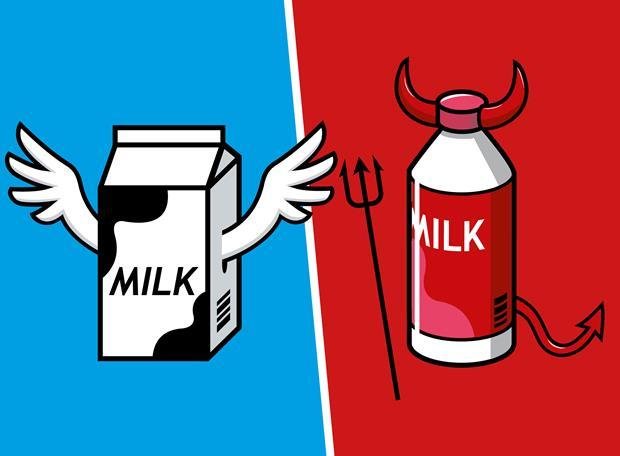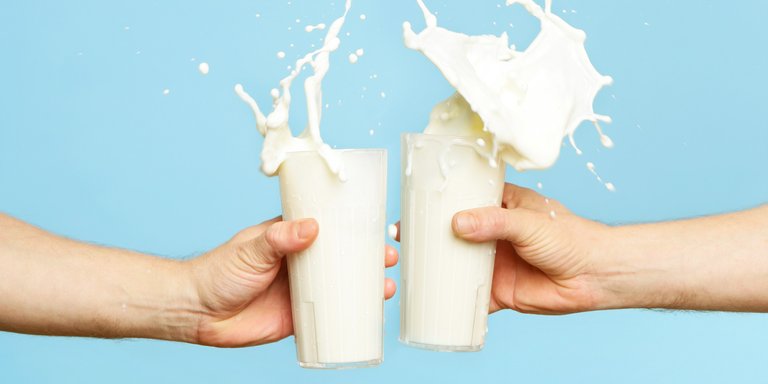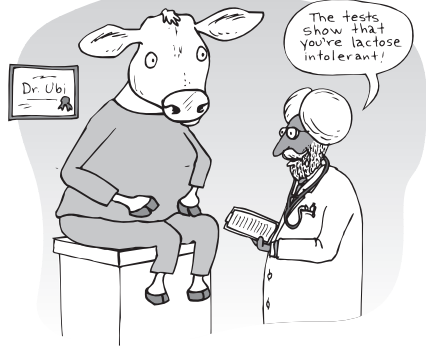what do milk and dairy do to your health, Calcium myths, not to mention skin problems we all have

milk and dairy products are advertised as wonder foods that will supply all the nutrients required for healthy growth. The calcium levels in milk, in particular, are stressed as an essential component of the human diet, and the impression is created that a loss of this dietary source of calcium will lead to abnormal bone development.

It is certainly true that dairy products are packed with nutrients, but this does not mean that the combination of nutrients is suited to human nutrition.
Mother's milk is essential for infants, but then infants are specially designed to cope with this growth-promoting food. Prior to weaning, the necessary enzyme systems needed for the digestion and assimilation of milk components are active, but they are progressively deactivated with age. The milk of other mammals also differs in composition from human milk, and this, together with the potential danger from ingested antigens, makes cow's milk unsuitable for human consumption.

There is considerable resistance from industry, and even from the established scientific world, to the idea that dairy consumption is detrimental to health, but the evidence from recent scientific findings seems fairly conclusive with regard to this issue. Dairy consumption is being coupled with a host of other diseases, and as consumption rises worldwide, so the evidence is becoming more and more conclusive.
In the past, the detrimental effect of the consumption of dairy products may have been masked by the positive effects of other lifestyle choices, such as higher consumption of grains, fresh fruits, and vegetables with their high fibre content. Western diets have, however, increased in the consumption of animal products, including dairy products, with a corresponding decline in the consumption of grains, legumes, fruits and vegetables, and this may explain the increase in the incidence of degenerative diseases in industrialized countries.

Lactose Intolerance
Lactose, the sugar in milk, is broken down in the intestines by the enzyme lactase. Most people are able to digest lactose properly during infancy and early childhood, but as they grow older this ability declines. Approximately 75% of adults worldwide are lactose intolerant.

Native Americans and Asians have the highest intolerance, and only slightly lower than these are the Blacks, Jews, Hispanics, and southern Europeans. Lactose intolerance is lowest among northern Europeans and their descendants. In the US some 25% of Caucasians, 51% of Hispanics, and 75% of all African Americans have insufficient levels of lactase to digest dairy products, whereas 90% of Asian Americans are lactose intolerant.i,ii
It has been found that 90% of African people are lactase deficient, and in the case of the rural Zulu of South Africa it was found that they showed no change in blood glucose concentrations after ingesting 50 g of lactose.iii When milk and dairy products are digested, lactose is broken down by the enzyme lactase into glucose and galactose.
The presence of lactose is a feature of mammalian milk, but the concentration of this sugar is normally geared to the needs of the species, as are the concentrations of all the other components of milk. Human milk does not only contain the essential nutrients that are required for growth and development, but also contains the bacterium bacillus bifidus that assists in the digestion of lactose.
In cow's milk, however, the bacterial composition differs from that of human milk. If cow's milk is fed to infants, this can interfere with the digestion of lactose. The lower protein and higher carbohydrate content of human milk is also more suited to the needs of infants, because their growth rates are considerably lower than those of calves.
After the conversion of lactose to glucose and galactose, the available galactose is not used as such, but is converted to glucose in the liver by a series of steps requiring the initial presence of the enzyme galactokinase. The production of both lactase and galactokinase declines with age, and the capacity to digest and utilize the products of lactose in adult life is thus curtailed. A deficiency in the enzyme lactase will result in fermentation of lactose by intestinal bacteria, which can result in abdominal distress such as gas, cramping, bloating, stomach rumbling, altered bowel habits, and diarrhea.iii The severity of the symptoms depends on the quantity of lactose consumed and the level of intolerance.
Milk Protein Intolerance
A further problem with milk is encountered in the digestion of the milk protein casein. In comparison to human milk, cow's milk contains 300% more casein and more than double the amount of total protein. Casein and beta-lactoglobulin are the two main proteins in milk and they are unique in that they contain a perfect blend of amino acids, which is precisely what is needed during early infant growth. Human infants, however, double their mass on average 180 days after birth, whereas cows achieve the same feat in only 47 days. Cow's milk is therefore geared to meet the rapid growth requirements of cows, but is not suitable for humans.

Casein also naturally stimulates thyroid function in infants, and as the thyroid is involved in many developmental processes, including the development of the nervous system, casein from other mammals could have adverse effects on metabolic processes of infants particularly since a portion of the dietary casein can be absorbed undigested and serve as antigen.
As with lactase, the concentration of the enzyme rennin, that breaks down the casein, also declines with age in all mammals. By the time milk teeth develop it is virtually non-existent in the human digestive tract. Without renin, the digestion of casein has to be carried out by the normal proteolytic enzymes which are not as efficient in breaking down casein.
The presence of casein in the diet of mammals has also been linked to elevated cholesterol levels and various degenerative diseases such as arteriosclerosis. Rabbits fed casein developed arteriosclerosis, but the effect could be reduced if a plant protein source, such as soybean flour was introduced into the diet. This shows that the amino acid pool produced by casein probably no longer meets the requirements of weaned or adult mammals.
Cow's milk also contains the following:
59 Active Hormones
Allergens
Fat
Cholesterol
Most of the dairy products we buy have the following in measurable quantities:
Herbicides
Pesticides
Dioxin (up to 2200 times the safe level)
Up to 52 powerful antibiotics
Blood
Pus
Bacteria and viruses

Casein also produced higher cholesterol levels than soy protein in a number of animal species, including rates, hamsters, guinea pigs, pigs, and monkeys. In humans, a reduction in cholesterol levels was also found if meat and dairy proteins were replaced by soy proteins.iv,v Casein also seems to have an adverse effect on insulin secretion, hormone levels, and calcium metabolism.
here is a lot of hype these days about getting enough calcium. The recommended dietary allowance (RDA) for calcium in the US is 1,200 mg per day. Americans consume huge quantities of calcium compared with most of the world. However, the United States has one of the highest rates of osteoporosis in the world. How are we consuming so much calcium, but still losing calcium from our bones?

Animal Proteins are the Culprit
In countries with plant-based diets, people consume little calcium and dairy. Still, osteoporosis levels are low in those nations.i
Researchers have discovered that a lack of calcium isn’t the problem. Rather, it’s the high amount of animal proteins we eat and drink. When we digest animal proteins, our bodies produce sulfuric acid, which must be buffered with calcium. This calcium is lost in urine along with the acid.ii
An x-ray of a hand. Wikimedia Commons
The best way to stop calcium loss is to eat fewer animal proteins, including those in dairy products like milk, eggs, and cheese. The American Dairy Council would have us believe that we must get calcium from dairy products in order to maintain strong bones. Yet “in one study (sponsored by the Dairy Council) women consuming three 8-ounce glasses of cow’s milk per day still lost calcium from their bodies, and remained in negative calcium balance, even after a year of consuming almost 1,500 mg of calcium daily.”iii
The good news is that the effects of osteoporosis can be prevented and reversed. We must simply adopt a diet low in animal proteins and get our calcium from plant sources. A 1981 study of calcium and protein levels showed that consuming 95 g of protein per day from animal sources and 1,400 mg of calcium supplements caused a net loss of nearly 30 mg of calcium from the bones everyday. However, a diet of only 48 g of animal proteins and 1,400 mg of calcium supplements caused a daily gain of 20 mg of calcium.iv But unlike animal protein, vegetable protein is not related to osteoporosis.v
The US RDA is 56 g for protein and 1,200 mg for calcium, because of calcium loss due to animal protein intake. The World Health Organization recommends “a more modest protein intake, 29 grams versus 56, and only 500 milligrams of calcium per day.”vi
The World Health Organization has also observed that “calcium deficiency has never been documented anywhere in the world, even with calcium intakes of as little as 300 mg/day.”vii It isn’t the lack of calcium in the diet that causes osteoporosis, but rather eating too much animal protein.
Calcium Absorption
Even though milk contains lots of calcium, humans only absorb 20-40% of that calcium. Humans absorb as much or more calcium from plant products than from milk.viii However, some plants contain compounds that block calcium absorption, like phytic acid in wheat bran cereal and oxalic acid in spinach.ix
Phosphorus Affects Calcium Absorption
The best calcium sources contain little phosphorus. Green leafy vegetables like kale, turnip greens, and mustard greens are excellent calcium sources and have three to five times more calcium than they have phosphorus.
Beef, pork, and fish have lots of phosphorus and hardly any calcium. Sesame seeds and tofu have nearly equal amounts of calcium and phosphorus. Carbonated beverages typically have 41 mg of phosphorus and no calcium.x Pepsi has 53 mg of phosphorus in a 12 oz can.xi Such drinks do not help our bodies benefit from the calcium in our food.
Salt and Osteoporosis
A low sodium diet also reduces the risk of osteoporosis.xii “When the kidneys excrete excess sodium, 23 to 26 mg of calcium is lost along with every gram of sodium excreted.”xiii
One teaspoon of salt contains 2,325 mg of sodium. The maximum sodium intake for a person with normal blood pressure is 2,400 mg per day.xiv Many meat substitutes, snacks, and bottled and canned foods are high in sodium. One tablespoon of Bragg Liquid Aminos holds 660 mg of sodiumxv and one can of cream of mushroom soup carries 2,111 mg of sodium.xvi

How to Get Enough Calcium
Do We Really Need Calcium Supplements?
“If calcium supplements are used, be sure they are not made from bone meal or oyster shell. These substances are often contaminated with arsenic, lead, or mercury, that accumulates in the bones and shells of these animals.”xvii
Nutritionists recommend that calcium be obtained from whole plant sources rather than from supplements.xviii Chemists have discovered how to make vitamin and mineral supplements more absorbable. But why pay high prices for bioengineered vitamins and minerals when God has already provided them in wholesome, natural plants? Calcium is waiting for you in the produce section of your grocery store, in the local farmer’s market, and in your own garden.
Calcium-rich Plant Foods
Here’s a list of foods that can provide plenty of calcium. Remember, on a low-protein diet of 30 g or less per day, especially protein from plant sources, daily calcium needs are only 500 mg.
Lambsquarters (1 cup = 464 mg calcium)
Collard greens (1 cup = 356 mg)
Amaranth grain (1 cup = 298 mg)
Figs, dried (10 = 269 mg)
Green soybeans (1 cup = 261 mg)
Tofu, firm (½ cup = 258 mg)
Turnip greens (1 cup = 249 mg)
Kale (1 cup = 179 mg)
Sesame seeds, dried (2 tbsp = 176 mg)
Blackstrap molasses (1 tbsp = 172 mg)
Okra, boiled (1 cup = 154 mg)
Baked beans (1 cup = 154 mg)
Mustard greens (1 cup = 152 mg)
Dandelion greens (1 cup = 146 mg)
Artichoke, boiled (1 medium = 135 mg)
Quinoa grain (1 cup = 102 mg)
Blackstrap molasses contains the highest amount of calcium. Carob powder, parsley, almonds, watercress, Brazil nuts, brewer’s yeast, and broccoli are also high in calcium. Sunflowers seeds, dried apricots, buckwheat, walnuts, and peanuts contain low to medium amounts of calcium as well.
There are delicious, healthy ways to get enough calcium without using dairy or fish. All it takes is education and a varied diet.
Awesome Job My Friend...
Cool profile! :)
Congratulations @healthyfitvegan! You have completed some achievement on Steemit and have been rewarded with new badge(s) :
Click on any badge to view your own Board of Honor on SteemitBoard.
For more information about SteemitBoard, click here
If you no longer want to receive notifications, reply to this comment with the word
STOP